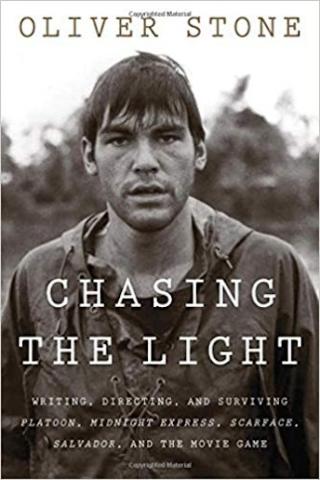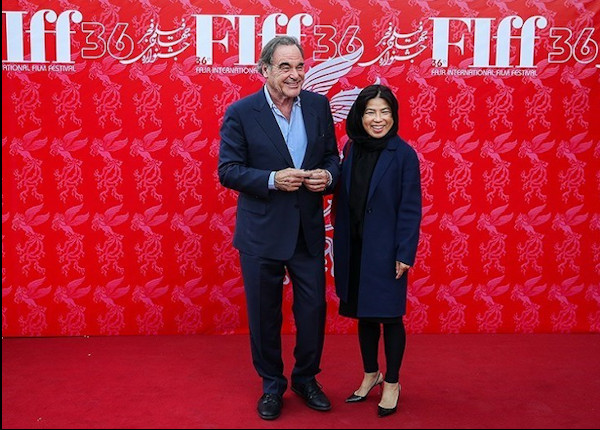Wars Fought, Scores Settled in Oliver Stone’s ‘Chasing the Light’

Chasing the Light: Writing, Directing, and Surviving Platoon, Midnight Express, Scarface,
Salvador, and the Movie Game
Oliver Stone
Houghton Mifflin Harcourt
342 pages
Generally speaking, memoirs are an opportunity for the author to reflect on past achievements, boast immodestly if so inclined, and otherwise describe for readers what “my life” is all about. Memoirs often take on the unique voice of a public figure—be it Michelle Obama, Mariah Carey or Ulysses S. Grant. So, it’s understandable if one expects the same approach in Chasing the Light, a memoir of Oliver Stone’s formative years.
Instead, what readers get is a somber and mostly clear-eyed recounting of Stone’s upbringing, schooling, wartime experiences in Vietnam, and (in some ways) equally tumultuous life of a screenwriter and director in the 1980s. The creator of classics like Platoon and Salvador has a lot to say about that era—and there’s no denying his life has been an eventful one.
The child of a doomed marriage, Stone vividly describes the domestic turmoil of his early years in New York and Connecticut. The restless son of a stockbroker and a vivacious French woman, Stone attended Yale, but dropped out and enlisted in the Marines at the height of the conflict in Vietnam. His experiences there, together with a sobering return to the States, were channeled into the making of Platoon, which remains among his signal achievements.

Throughout Chasing the Light, the war in Vietnam is the linchpin—and the source of much of the book’s most intense writing:
“And now there was an enormous roar, like I suppose the end of the world sounds. So quickly, like a shark cutting through water, an F-16 jet fighter was coming in very low over our perimeter out of the lit night sky. So low, that doomsday sound—we were all going to die. This was crazy—they were going to drop their payload on us! I jumped into the scared man’s foxhole and buried myself as deep as I could in the earth, which trembled and shook as a five-hundred-pound bomb dropped somewhere close. Somebody was being shredded to pieces, my God!”
And, of course, there are scores to settle—with the cantankerous director of Midnight Express, a producer Stone deems “difficult,” and a major film star who, at a critical moment of pre-production, was “weak” and “evasive.” There’s also an extended account of the travails involved in filming Salvador in Mexico, particularly Stone’s effort to contain the excesses of the film’s leading man.
One might have thought the writer/director of movies like Scarface would be too loud and contentious to dependably relate the chaos of a film set on location. But, surprisingly perhaps, there’s little of a swaggering tone here that matches the bombast of Stone’s biggest films.

Often, Chasing the Light has an “as-told-to” quality, in contrast to a series of carefully wrought sentences and lyrical flights of fancy. For example, here he describes the aftermath of his failed first marriage, especially the effect it had on his soon-to-be ex-wife:
“What could I be but a bastard! Break hearts. No, not really, But I was a child of divorce, yes. Why not, it’s the way of the world. Didn’t you meet my parents? Didn’t you see this coming—that great mistake they committed when they married and begat me? I brushed one of her tears away and left her without the love I could not give. The door closed on her broken expression, and feeling coldhearted, I walked down the hall, down the stairs, and into the street, where I inhaled the first fresh breath of air that I’d had in … years.”
Paradoxically, the relative artlessness in this stream-of-consciousness passage echoes the intimacy of Stone’s best work, both on the page and on the screen. Chasing the Light will be of interest to fans of his early films (the memoir ends, rather abruptly, with the Academy Awards of 1987) and those seeking an inside look at the tempestuous landscape of Hollywood.
Author Bio:
Lee Polevoi, Highbrow Magazine’s chief book critic, is the author of a novel, The Moon in Deep Winter.
For Highbrow Magazine
Image Sources:
--Houghton Mifflin Harcourt
--Hamed Malekpour (Tasnim News Agency, Wikimedia.org, Creative Commons)
--Orion Pictures































































































































































































































































































































